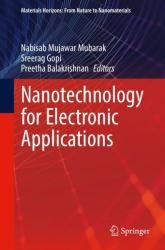Nanotechnology for Electronic Applications
- Добавил: literator
- Дата: 3-02-2022, 18:28
- Комментариев: 0
 Название: Nanotechnology for Electronic Applications
Название: Nanotechnology for Electronic ApplicationsАвтор: Nabisab Mujawar Mubarak, Sreerag Gopi, Preetha Balakrishnan
Издательство: Springer
Год: 2022
Страниц: 270
Язык: английский
Формат: pdf (true)
Размер: 10.2 MB
This book provides an overview of the electronic applications of nanotechnology. It presents latest research in the areas of nanotechnology applied to the fields of electronics and energy. Various topics covered in this book include nanotechnology in electronic field, electronic chips and circuits, batteries, wireless devices, energy storage, semiconductors, fuel cells, defense and military equipment, and aerospace industry, This book will be useful for engineers, researchers and industry professionals primarily in the fields of electrical engineering engineering, materials science and nanotechnology.
The term nanoelectronic/magnetic is associated with nanotechnology in the electronic/magnetic field. Nanomagnetics have always been in existence but have been recently discovered. Natural existent nanomagnetics originate as magnetite (Fe3O4), which is found in bacteria, molluscs, and insects. Magnetite is found to be 40–100 nm in length. Currently, there is a great investment done toward nanoelectronics/magnetics throughout the world.
Microprocessors (CPU) are the main hub for all computers, and with increasing demand for faster and smaller microprocessors, the transistors located inside the chips heat up. With technology evolving rapidly, the chips are becoming more densely packed giving rise to the problem of overheating. Carbon nanotubes (CNTs) have demonstrated high thermal conductivity; however, their chemical interaction with other materials has been weak, hampering the idea of combining CNTs and other materials.
Physicist, Frank Ogletree, and his team performed a study incorporating organic molecules between carbon nanotubes and metal surfaces. Researchers developed “covalent bond pathways that work for oxide-forming materials such as aluminum and silicon, and for noble metals, such as gold and copper”. Interaction between the two substances was drastically improved through implementing reactive molecules as a bridge among the CNTs and metal surfaces. “Aminopropyl-trialkoxy-silane (APS) for oxide-forming metals, and cysteamine for noble metals” were used to bridge the two substances together. This was developed by growing vertically aligned CNTs arrays on silicon wafers and thin films of metal (gold or aluminum) were evaporated on cover slips. The metal slips were functionalized with the appropriate reactive molecules allowing bonding with the CNTs. To validate the process, a characterization technique that measures interface-specific heat transport was conducted and provided results with enhanced heat flow.
Скачать Nanotechnology for Electronic Applications
[related-news] [/related-news]
Внимание
Уважаемый посетитель, Вы зашли на сайт как незарегистрированный пользователь.
Мы рекомендуем Вам зарегистрироваться либо войти на сайт под своим именем.
Уважаемый посетитель, Вы зашли на сайт как незарегистрированный пользователь.
Мы рекомендуем Вам зарегистрироваться либо войти на сайт под своим именем.
